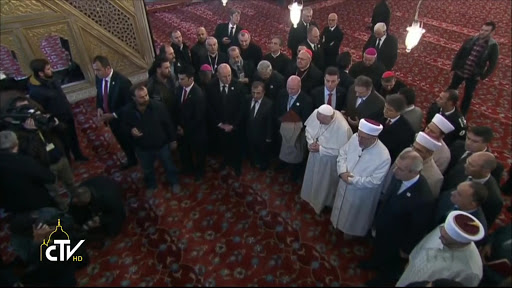In big, historic state visits, little things can mean a lot. Throughout Pope Francis’ recent visit to Turkey, which commenced yesterday with the Pope’s arrival in the capital of Ankara, he and his hosts have built up a mosaic of small but significant gestures.
Francis’ moves so far appear designed to reconcile the opposites within Turkey. One of his first stops was the tomb of Mustafa Kemal Atatürk, at which he lay a wreath. Atatürk, who first earned the status of national hero resisting the Allied landings at Gallipoli, during the First World War, went on to serve as first president of the Republic of Turkey, a secular state.
Later that same day, the Pope met with Mehmet Görmez, a bearded Muslim cleric who serves as the head of Turkey’s Presidency of Religious Affairs. In an address to assembled Turkish dignitaries, including President Recep Tayyip Erdoğan, he called for “the solidarity of believers” in rolling back Middle Eastern religious fanaticism.
Today, after flying to Istanbul, the Pope paid a visit to the Hagia Sophia and the Blue Mosque, which face one another across a mall in Istanbul’s Sultanahmet district. In the Blue Mosque, which gets its name from the tens of thousands of tiles bearing blue designs and covering its interior walls, the Pontiff stood side-by-side with Rahmi Yaran, Istanbul’s mufti, in what Vatican spokespeople call “a moment of silent adoration of God.”
During the moment of adoration, Francis clasped his hands; the mufti raised his in the orans position. Both faced Mecca.
Later, Yaran presented Francis with a blue tile made in Iznik, formerly Nicaea, site of historic Church councils. The tile bore the image of a tulip, a flower popularized in the West by an Austrian ambassador to Istanbul who was taken with the sight of them growing in the sultan’s gardens.
Today, Turks regard the tulip as a symbol of their country as a whole, and of Istanbul in particular. Turkish historians call the period between 1718 and 1730 the Tulip Period, or the Lale Devri. It was a decade of peace, prosperity, and conspicuous consumption in which tulips became the ultimate status symbol.
Earlier in the day, Pope Francis visited the Hagia Sophia — for almost 1,000 years a Christian basilica, for almost 500 years a mosque, since 1934 a museum. Though the Pope listened as museum director Hayrullah Cengiz held forth on the building’s history, he did not pray. This sets him in contrast to Pope Paul VI, who did fall to his knees in prayer during a 1967 visit, inciting protests from Turks determined to keep the space secular.
Increasingly, conservative Muslims have been pressuring the government to turn the Hagia Sophia back into a mosque. This past May, tens of thousands demonstrated in front of the building with that aim in mind. A petition circulated by the Anatolia Youth Association drew 15 million signatures — a bracing number, given Turkey’s overall population of 77 million. Turkish Deputy Prime Minister Bülent Arınç has consistently spoken of the Hagia Sophia as a mosque, promising, “hopefully we will see it smiling again soon."
So far, President Erdoğan has shown no enthusiasm for such a project, remarking that there was no point, since the Blue Mosque remained largely empty during
Friday prayers.
Friday prayers.
However, in an exchange of gifts with the Pope during yesterday’s meeting, Erdoğan did show a touch of nostalgia for the Ottomans, presenting Francis with a 15
th-century edict guaranteeing freedom of worship to Bosnian Christians. The issuing authority was none other than Mehmet II, or Mehmet the Conqueror, who finally captured Constantinople — including the Hagia Sophia — from the Byzantines.
th-century edict guaranteeing freedom of worship to Bosnian Christians. The issuing authority was none other than Mehmet II, or Mehmet the Conqueror, who finally captured Constantinople — including the Hagia Sophia — from the Byzantines.
Observers of Turkish foreign policy have used the term neo-Ottomanism to describe Turkey’s recent efforts to extend its influence throughout the Middle East — in particular, countries that once belonged to the Ottoman Empire.
Although Turkish Foreign Minister Ahmet Davutoğlu has rejected the term, insisting, “The Turkish republic is a modern nation state,” he has also declared Turkey heir to the eastern — or Byzantine — Roman Empire.
“The persons who desire to understand Turkey’s foreign policy need to understand what decision Rome would have made,” he has said.
In his Ankara address, Pope Francis tacitly acknowledged Turkey’s regional prominence. “Turkey, by virtue of its history, geographical position and regional influence, has a great responsibility,” he said. “The choices which Turkey makes and its example are especially significant and can be of considerable help in promoting an encounter of civilizations and in identifying viable paths of peace and authentic progress.”
Whatever Erdoğan’s and Yaran’s gifts may say about their views of the past and future, the government seems determined to keep the Pontiff safe in the present. Hundreds of policemen kept crowds — “of tourists and curious locals,” according to the Guardian — behind barricades. The attempt on Pope St. John Paul II’s life by a Turk, Mehmed Ali Ağca, is one historical chapter that nobody seems eager to repeat.
Max Lindenman
writes from Turkey

